
Welcome to Hyperion Records, a British classical label devoted to presenting high-quality recordings of music of all styles and from all periods from the twelfth century to the twenty-first.
Hyperion offers both CDs, and downloads in a number of formats. The site is also available in several languages.
Please use the dropdown buttons to set your preferred options, or use the checkbox to accept the defaults.

 PERFORMANCE
PERFORMANCE RECORDING
RECORDING
 PERFORMANCE
PERFORMANCE RECORDING
RECORDINGThe six Images were in Debussy’s mind in some form as early as December 1901, when he played versions of two of them (‘Reflets dans l’eau’ and ‘Mouvement’) to Ricardo Viñes, but the complete list of titles was not fixed until July 1903, when he sent these to the publisher Fromont. He had just completed the Estampes, and the Images, the first book of which was published in October 1905, can be heard as a development along the same colouristic lines, following earlier intimations in various pieces by Chabrier and in Ravel’s Jeux d’eau. The technique has been called one of illusion—what you see on the printed page is often not at all what you get, depending largely on your use of the sustaining pedal—but equally Debussy shared the concerns of such ‘colourful’ composers as Berlioz and Liszt that overtly descriptive music should also work in purely structural terms.
The small wave forms of ‘Reflets dans l’eau’ and its key of D flat major might suggest it was a spin-off from La mer, except that the above chronology points, if anything, to the relationship being reversed. Debussy jokingly referred to the piece as being written ‘according to the most recent discoveries in harmonic chemistry’. While this is, no doubt intentionally, a trifle exaggerated, what is disturbing is the way the dreamlike opening, a standard eight-bar phrase, is immediately interrupted by chromatic chords: throughout the piece, the reflections in the water go on being unsettled by pebbles thrown from an unseen hand. The essential circularity of this piece is echoed in the final ‘Mouvement’, which is almost an early Étude (‘Pour les triolets’?). Marked to be played ‘with a fantastical but precise lightness’, it achieves an extraordinary rapprochement between academic note-spinning and imaginative atmosphere, with a few fanfares added for good measure. The central ‘Hommage à Rameau’, while outwardly placid and monumental, partakes of more traditional rhetorical structures and of the effortless internal dynamism that is so much a part of the genius of Rameau, ‘without any of that pretence towards German profundity, or to the need of emphasizing things with blows of the fist’, as Debussy put it when reviewing a performance of the first two acts of Rameau’s Castor et Pollux in 1903—which possibly inspired his piece, although searches for direct quotations from the earlier composer have so far proved fruitless.
from notes by Roger Nichols © 2017
Debussy avait à l’esprit les six Images dès décembre 1901, quand il joua une version de deux d’entre elles («Reflets dans l’eau» et «Mouvement») au pianiste Ricardo Viñes, mais la liste complète des titres ne fut pas arrêtée avant juillet 1903, date de son envoi à l’éditeur Fromont. Il venait de terminer les Estampes et on peut envisager les Images—dont le premier cahier parut en octobre 1905—comme un développement appuyé sur les mêmes lignes de coloriste, en suivant ce que suggéraient les partitions antérieures de Chabrier et les Jeux d’eau de Ravel. Cette technique eut beau être qualifiée d’«illusion»—ce que l’on voit sur la page imprimée n’a souvent rien à voir avec le résultat, lequel dépend, essentiellement, de l’usage que l’on fait de la pédale de prolongation—, Debussy partageait les soucis de compositeurs «coloristes» comme Berlioz ou Liszt, pour qui la musique descriptive devait aussi fonctionner en termes purement structuraux.
Les formes de vaguelettes et la tonalité de ré bémol majeur pourraient laisser penser que les «Reflets dans l’eau» sont issus de La mer, sauf que la chronologie susmentionnée indique plutôt le contraire. Debussy disait de cette pièce, en plaisantant, qu’elle avait été écrite «selon les découvertes les plus récentes de la chimie harmonique». Même si c’est un peu exagéré, intentionnellement sans aucun doute, on est perturbé par la manière dont l’ouverture onirique—une phrase standard de huit mesures—est immédiatement interrompue par des accords chromatiques: tout au long du morceau, des cailloux lancés par une main invisible viennent sans cesse troubler les reflets dans l’eau. La circularité fondamentale de cette pièce trouve un écho dans le «Mouvement» final, qui est presque une Étude précoce («Pour les triolets»?). Devant être joué «avec une légèreté fantastique mais précise», il réussit un extraordinaire rapprochement entre filage de notes académique et atmosphère originale avec ajout de quelques fanfares pour faire bonne mesure. L’«Hommage à Rameau» central, malgré son apparence placide et monumentale, reprend largement les structures rhétoriques traditionnelles et l’infatigable dynamisme interne inhérent au génie de Rameau. Il ne possède pourtant rien de cette prétention à la profondeur allemande ni de ce besoin d’insister sur les choses à coups de poing, comme le dira en substance Debussy dans un compte-rendu (1903) des deux premiers actes du Castor et Pollux de Rameau—dont il s’inspira peut-être pour son «Hommage» même si, pour l’heure, aucune citation directe n’a pu être trouvée.
extrait des notes rédigées par Roger Nichols © 2017
Français: Hypérion
Debussy hatte bereits im Dezember 1901 Ideen zu den sechs Images im Kopf, als er dem Pianisten Ricardo Viñes frühe Fassungen von „Reflets dans l’eau“ und „Mouvement“ vorspielte, doch die komplette Titelliste wurde erst im Juli 1903 festgelegt, als Debussy sie dem Fromont Verlag zuschickte. Er hatte gerade die Estampes fertiggestellt, und die Images, deren erstes Heft im Oktober 1905 veröffentlicht wurde, können als Fortführung des gleichen kolorit-betonten Stils verstanden werden, welcher auch schon früher in verschiedenen Stücken Chabriers sowie bei Ravels Jeux d’eau angedeutet worden war. Diese Vorgehensweise wird als Technik der Illusion bezeichnet—was man auf der gedruckten Seite sieht, ist oft nicht annähernd das, was man zu hören bekommt, je nach Einsatz des rechten Pedals. Wie anderen „farbenfrohen“ Komponisten, wie etwa Berlioz oder Liszt, war aber auch Debussy gleichzeitig daran gelegen, dass äußerlich beschreibende Musik ebenfalls rein strukturellen Maßstäben folgen sollte.
Die kleinen Wellenbewegungen von „Reflets dans l’eau“ sowie die Tonart Des-Dur könnten darauf hinweisen, dass es sich bei dem Werk um eine Art Nebenprodukt von La mer handelt, obwohl die oben angeführte Chronologie allenfalls auf das Gegenteil hindeutet. Debussy behauptete scherzhaft, diese Komposition sei „nach den letzten Erkenntnissen der harmonischen Chemie“ entstanden. Obwohl er damit wohl ein wenig übertreibt, ist die Art und Weise, wie die verträumte Eröffnung, eine herkömmliche achttaktige Phrase, sofort durch chromatische Akkorde unterbrochen wird, durchaus beunruhigend: Während des ganzen Stücks werden die Spiegelungen der Wasseroberfläche immer wieder wie durch Kieselsteine, geworfen von ungesehener Hand, gestört. Die grundlegende Kreisförmigkeit des Werks klingt im abschließenden „Mouvement“ nach, das eigentlich fast eine frühe Étude ist (etwa „Pour les triolets“?). Durch die Anweisung, dass es „mit fantastischer aber präziser Leichtigkeit“ zu spielen sei, erzielt das Stück ein außergewöhnliches Zusammenkommen von akademischer Notenspinnerei und fantasievoller Atmosphäre—mit noch ein paar Fanfaren als Dreingabe. Das zentrale „Hommage à Rameau“ ist zwar äußerlich ruhig und monumental, greift jedoch auch auf traditionellere rhetorische Strukturen sowie die dem Genie Rameaus so eigene, mühelose innere Dynamik zurück. Und das „ohne jenes Vorgeben deutscher Tiefe oder des Bedürfnisses, alles mit der Faust zu unterstreichen“, wie es Debussy selbst 1903 in der Rezension einer Aufführung der ersten beiden Akte von Rameaus Castor et Pollux formulierte—möglicherweise die Inspiration für sein eigenes Stück, obwohl sich die Suche nach direkten Zitaten des früheren Komponisten bisher als fruchtlos erwiesen hat.
aus dem Begleittext von Roger Nichols © 2017
Deutsch: Bettina Reinke-Welsh
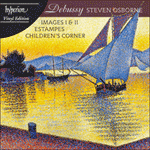 Debussy: Images, Estampes & Children's Corner - Vinyl Edition Debussy: Images, Estampes & Children's Corner - Vinyl EditionSteven Osborne returns to the music of Debussy, delivering masterly accounts of three major piano works.» More |
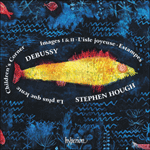 Debussy: Piano Music Debussy: Piano MusicAny release from Stephen Hough is a keenly awaited event, and this recital of some of Debussy’s best-loved works for solo piano set the bar high in the centenary year of the composer’s death.» More |
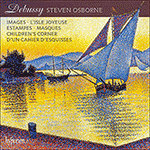 Debussy: Piano Music Debussy: Piano MusicSteven Osborne returns to the music of Debussy, delivering masterly accounts of three major piano works.» More |
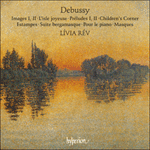 Debussy: Piano Music Debussy: Piano Music‘Distinctive and distinguished performances’ (BBC Music Magazine) ‘Very distinguished playing indeed and must be strongly recommended’ (The Penguin Guide to Compact Discs)» More |
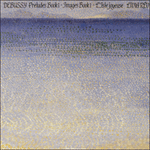 Debussy: Preludes Book 1 Debussy: Preludes Book 1 |
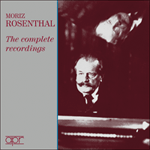 Moriz Rosenthal - The complete recordings Moriz Rosenthal - The complete recordings‘Rosenthal had an inimitably seductive manner of playing … with Ward Marston’s superb restoration and remastering, APR’s exemplary annotation and ... ‘The artistry of Moriz Rosenthal (1862-1946) arguably stands head and shoulders above all recorded Liszt pupils’ (Classics Today)» More |
 Eileen Joyce - The complete Parlophone & Columbia solo recordings Eileen Joyce - The complete Parlophone & Columbia solo recordings‘Listening to Joyce is strangely addictive. One cannot wait, as it were, to read the next chapter. She shares with Kreisler and Tauber the same unteac ... ‘The quality that comes across in these performances is the sheer joy of playing. Joyce possessed a formidable technique and an interpretative mind th ...» More |
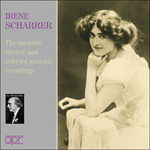 Irene Scharrer - The complete electric and selected acoustic recordings Irene Scharrer - The complete electric and selected acoustic recordings‘If [Irene Scharrer]'s remembered from her recordings it’s really only the one, and that was ironically the last she made, Litolff’s Scherzo from the ...» More |
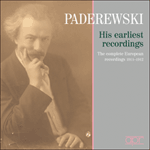 Paderewski - His earliest recordings Paderewski - His earliest recordings |
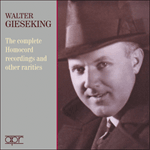 Walter Gieseking - The complete Homocord recordings and other rarities Walter Gieseking - The complete Homocord recordings and other raritiesWalter Gieseking is known as one of the greatest 20th-century pianists, and his playing of Debussy and Ravel in particular is often regarded as definitive. For most of his recording career he recorded for Columbia, but his earliest recordings were ...» More |

